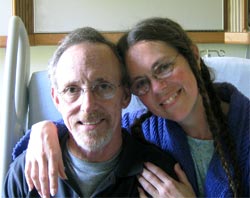Neurosurgeon: Gary K. Steinberg, MD, PhD, Stanford University Medical Center, Stanford, Calif.
Patient: Patti A. Gilstrap, age 49, Cavernous Malformations
On Nov. 7, 1987, my first bleed presented itself with a first-time generalized seizure. Months following the conclusion of my diagnosis and decision of whom and where to go for surgical treatment, I underwent my first brain surgery on Jan. 29, 1988. Charles B. Wilson, MD, who is now retired from the University of California, San Francisco, performed the surgery to remove the cavernous malformation located in my left parietal lobe.

I have multiple cavernous malformations throughout my brain which are considered familial, but after my first surgery, I had not yet grasped the reality that I could experience another bleed. Because I have multiple cavernous malformations, I need to get a yearly MRI to check for progression and signs of recent bleeding.
In November 2001, my husband Rick and I were out of town celebrating our first wedding anniversary when a second bleed presented itself with a generalized seizure. Unfortunately, the medical staff at my small-town hospital ignored my cavernous malformation history, focusing all their attention on my Dilantin level and sent me out the door without even a CT scan.
From my past involvement in the Arteriovenous Malformation (AVM) Support Group in the Bay area, I knew Gary K. Steinberg, MD, PhD, a neurosurgeon at Stanford University Medical Center. I referred myself to him for consultation. He recommended surgery, and on Jan. 11, 2002, I underwent my second craniotomy. Surgery went well, and I continued to get MRIs annually and send them to him for review.
On Dec. 4, 2008, I had my annual MRI and sent it off to Dr. Steinberg. Words cannot express the shock I felt when I learned I had another bleed. On March 17, 2009, I underwent my third brain surgery, and my recovery is going well.
With all three surgeries, I was fortunate to have the very best care/treatment and to have that sacred trust in my neurosurgeon. Trust in your surgeon is extremely important, as is finding a neurosurgeon highly experienced and skilled in treating vascular malformations. The treatment of AVMs and cavernous malformations is a subspecialty within the specialty of neurosurgery. It is not unusual for patients to have to consult with a specialist outside their geographic area, as I did.
Until we live in a “perfect” world where ALL medical communities are well versed in the proper treatment of these malformations, as well as other lesser known conditions, patients must serve as their own health-care advocates.
Note from AANS
The AANS does not endorse any treatments, procedures, products or physicians referenced in these patient fact sheets. This information is provided as an educational service and is not intended to serve as medical advice. Anyone seeking specific neurosurgical advice or assistance should consult his or her neurosurgeon, or locate one in your area through the AANS’ Find a Board-certified Neurosurgeon online tool.
